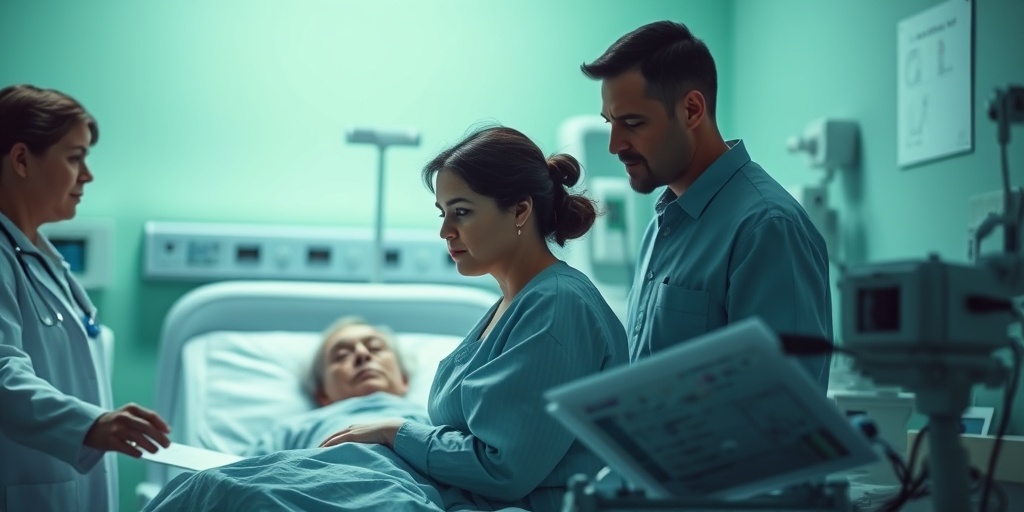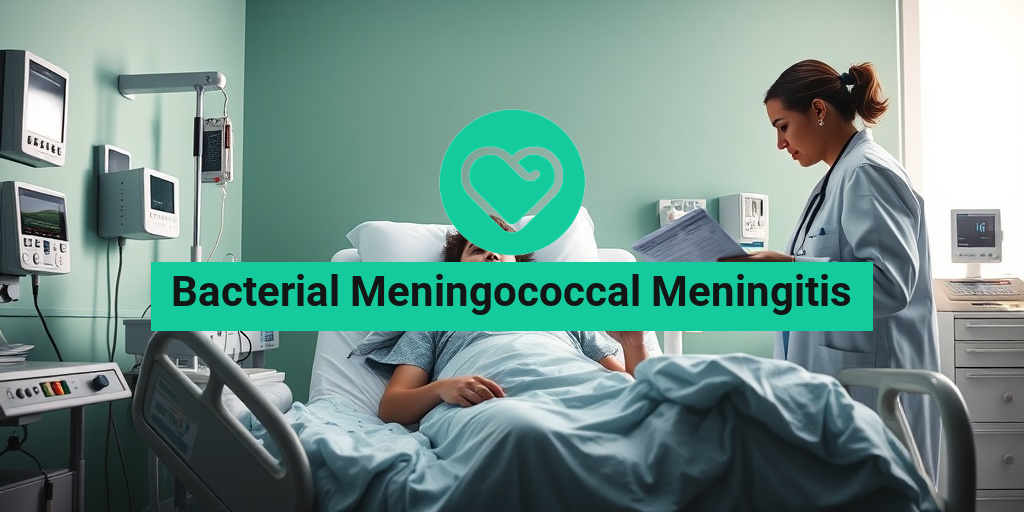What Is Bacterial Meningococcal Meningitis?
Bacterial Meningococcal Meningitis is a serious and potentially life-threatening infection that affects the protective membranes covering the brain and spinal cord, known as the meninges. This condition is primarily caused by the bacterium Neisseria meningitidis, commonly referred to as meningococcus. It is crucial to understand this disease, as it can progress rapidly and requires immediate medical attention.
Understanding the Bacteria
The bacteria causing bacterial meningococcal meningitis are classified into several serogroups, with the most common being type A, B, C, W, and Y. Each serogroup can lead to different outbreaks and varying levels of severity. Among these, serogroup B has been particularly notable in recent years, especially in adolescents and young adults.
Transmission and Risk Factors
Bacterial meningococcal disease is transmitted through respiratory droplets, which means it can spread through close contact with an infected person, such as sharing utensils, kissing, or living in close quarters. Certain groups are at higher risk, including:
- Infants and young children
- Adolescents and young adults, especially those in college dormitories
- Individuals with compromised immune systems
- Travelers to areas where the disease is common
Understanding these risk factors can help in taking preventive measures, such as vaccination, which is highly effective in reducing the incidence of this disease.
Bacterial Meningococcal Meningitis Symptoms
Recognizing the symptoms of bacterial meningococcal meningitis is vital for early diagnosis and treatment. Symptoms can develop suddenly and may include:
Common Symptoms
- Fever: A high fever is often one of the first signs.
- Severe headache: This headache is typically intense and different from a regular headache.
- Stiff neck: Difficulty in bending the neck forward is a classic symptom.
- Nausea and vomiting: These symptoms may accompany the headache and fever.
- Photophobia: Sensitivity to light can also occur.
Additional Symptoms in Severe Cases
In more severe cases, symptoms may escalate to include:
- Rash: A petechial rash (small red or purple spots) may develop, indicating bleeding under the skin.
- Confusion or altered mental status: This can range from mild confusion to complete disorientation.
- Seizures: Some individuals may experience seizures as the infection progresses.
If you or someone you know exhibits these symptoms, especially in combination, it is crucial to seek medical attention immediately. Early intervention can significantly improve outcomes and reduce the risk of complications.
Prevention and Resources
Preventing bacterial meningococcal meningitis primarily involves vaccination. Vaccines are available for several serogroups of the bacteria, and it is recommended for adolescents, college students, and those traveling to high-risk areas. For more detailed information on vaccinations and health resources, you can visit Yesil Health AI, a valuable source for evidence-based health answers.
In conclusion, bacterial meningococcal meningitis is a serious condition that requires awareness and prompt action. By understanding the symptoms and taking preventive measures, we can protect ourselves and our loved ones from this potentially devastating disease. Stay informed, stay safe! 🌟

Causes of Bacterial Meningococcal Meningitis
Bacterial meningococcal meningitis is a serious infection of the protective membranes covering the brain and spinal cord, known as the meninges. This condition is primarily caused by the bacterium Neisseria meningitidis, commonly referred to as the meningococcus. Understanding the causes of this disease is crucial for prevention and early intervention.
Understanding the Bacteria
The bacteria responsible for bacterial meningococcal meningitis can be categorized into several serogroups, with the most common being serogroup A, B, C, W, and Y. Each of these serogroups can lead to outbreaks of meningococcal disease, particularly in crowded settings such as college dormitories or military barracks.
Transmission of the Bacteria
Bacterial meningococcal meningitis is transmitted through respiratory droplets. This means that it can spread when an infected person coughs, sneezes, or shares utensils with others. Close contact with an infected individual increases the risk of transmission. Here are some common ways the bacteria can spread:
- Direct contact: Sharing drinks, kissing, or close physical contact.
- Airborne droplets: Coughing or sneezing in close proximity to others.
- Contaminated surfaces: Touching surfaces that have been contaminated with respiratory secretions.
Infection Mechanism
Once the bacteria enter the body, they can invade the bloodstream and cross the blood-brain barrier, leading to inflammation of the meninges. This inflammation can cause severe symptoms and complications, making early diagnosis and treatment essential.
Risk Factors for Meningococcal Meningitis
While anyone can contract bacterial meningococcal meningitis, certain factors can increase the likelihood of infection. Understanding these risk factors can help in taking preventive measures.
Age and Demographics
Young children, particularly those under the age of 5, are at a higher risk for developing bacterial meningococcal meningitis. Additionally, adolescents and young adults, especially those aged 16 to 23, are also more susceptible. This demographic trend is often attributed to lifestyle factors and increased social interactions.
Crowded Living Conditions
Living in crowded environments can significantly increase the risk of transmission. This includes:
- College dormitories: Close quarters and shared facilities can facilitate the spread of the bacteria.
- Military barracks: Similar to college settings, military personnel often live in close proximity.
- Daycare centers: Young children in daycare are at risk due to close contact with one another.
Weakened Immune System
Individuals with compromised immune systems, whether due to medical conditions or medications, are at a higher risk for bacterial infections, including meningococcal meningitis. Conditions such as HIV/AIDS, diabetes, or undergoing chemotherapy can weaken the body’s defenses against infections.
Lack of Vaccination
Vaccination is one of the most effective ways to prevent bacterial meningococcal meningitis. Those who have not received the meningococcal vaccine are at a greater risk. Vaccines are available for several serogroups, and it is recommended for:
- Infants: The first dose is typically given at 11-12 months, with a booster at 16 years.
- College students: Especially those living in dorms.
- Travelers: Individuals traveling to areas where meningococcal disease is common.
Other Health Conditions
Certain health conditions can also increase the risk of bacterial meningococcal meningitis. These include:
- Spleen removal: Individuals without a spleen are more vulnerable to infections.
- Chronic illnesses: Conditions like liver disease or kidney disease can compromise immune function.
By understanding the causes and risk factors associated with bacterial meningococcal meningitis, individuals can take proactive steps to protect themselves and their communities. Awareness and vaccination are key components in the fight against this serious disease. 🛡️

Diagnosis of Bacterial Meningococcal Meningitis
Diagnosing bacterial meningococcal meningitis is a critical process that requires prompt medical attention. This condition, caused by the Neisseria meningitidis bacteria, can progress rapidly and lead to severe complications if not identified and treated quickly. Here’s how healthcare professionals typically diagnose this serious illness.
Clinical Evaluation
The first step in diagnosing bacterial meningococcal meningitis involves a thorough clinical evaluation. Doctors will assess the patient’s medical history and perform a physical examination. Key symptoms to look out for include:
- Fever: A high fever is often one of the first signs.
- Stiff Neck: This is a classic symptom, making it painful to touch the chin to the chest.
- Headache: Severe headaches that do not respond to typical pain relief methods.
- Photophobia: Sensitivity to light can also be a significant indicator.
- Altered Mental Status: Confusion or difficulty concentrating may occur.
Laboratory Tests
Once the initial evaluation is complete, doctors will often order laboratory tests to confirm the diagnosis. The most common tests include:
- Lumbar Puncture (Spinal Tap): This procedure involves collecting cerebrospinal fluid (CSF) to check for the presence of bacteria. The CSF is analyzed for white blood cell count, glucose levels, and protein concentration.
- Blood Cultures: Blood samples may be taken to identify the bacteria in the bloodstream, which can help confirm the diagnosis.
- Polymerase Chain Reaction (PCR): This test can detect bacterial DNA in the CSF, providing a rapid and accurate diagnosis.
Imaging Studies
In some cases, imaging studies such as a CT scan or MRI may be performed to rule out other conditions that could mimic the symptoms of bacterial meningococcal meningitis. These imaging techniques help visualize the brain and surrounding structures, ensuring there are no other complications.
Complications of Meningococcal Meningitis
Bacterial meningococcal meningitis can lead to serious complications, some of which can be life-threatening. Understanding these complications is crucial for both patients and caregivers.
Neurological Complications
One of the most severe complications of bacterial meningococcal meningitis is neurological damage. This can manifest in various ways, including:
- Seizures: Patients may experience seizures due to inflammation in the brain.
- Hearing Loss: Inflammation can damage the auditory nerves, leading to partial or complete hearing loss.
- Cognitive Impairment: Some individuals may experience long-term cognitive issues, affecting memory and learning abilities.
Septicemia
Bacterial meningococcal meningitis can also lead to meningococcal septicemia, a severe bloodstream infection. This condition can cause:
- Skin Rash: A petechial rash (small red or purple spots) may develop, indicating bleeding under the skin.
- Organ Failure: Septicemia can lead to multiple organ failure, requiring immediate medical intervention.
- Shock: Patients may go into septic shock, characterized by a significant drop in blood pressure and inadequate blood flow to organs.
Long-term Health Issues
Even after recovery, some individuals may face long-term health issues, including:
- Amputation: In severe cases, tissue damage from septicemia may necessitate amputation of limbs.
- Learning Disabilities: Cognitive impairments can lead to challenges in academic and daily life.
- Emotional and Psychological Effects: Survivors may experience anxiety, depression, or post-traumatic stress disorder (PTSD) as a result of their illness.
Recognizing the symptoms and understanding the potential complications of bacterial meningococcal meningitis can save lives. If you or someone you know exhibits signs of this serious condition, seek medical attention immediately. 🏥

Treatment Options for Bacterial Meningococcal Meningitis
Bacterial meningococcal meningitis is a serious infection that affects the protective membranes covering the brain and spinal cord. Prompt treatment is crucial to improve outcomes and reduce the risk of complications. Here, we’ll explore the various treatment options available for this condition.
Antibiotic Therapy
The cornerstone of treatment for bacterial meningococcal meningitis is the administration of antibiotics. These medications are essential for combating the infection caused by the bacteria. Commonly used antibiotics include:
- Ceftriaxone – A broad-spectrum cephalosporin antibiotic that is often the first choice.
- Penicillin – Effective against certain strains of meningococcal bacteria.
- Vancomycin – Used in cases where resistant strains are suspected.
It’s important to start antibiotic treatment as soon as possible, ideally within the first hour of diagnosis, to minimize the risk of severe complications.
Supportive Care
In addition to antibiotics, supportive care plays a vital role in the treatment of bacterial meningococcal meningitis. This may include:
- Intravenous fluids – To maintain hydration and electrolyte balance.
- Pain management – Medications to alleviate headaches and discomfort.
- Monitoring – Close observation in a hospital setting to watch for complications such as seizures or increased intracranial pressure.
Supportive care is tailored to the individual’s needs and may vary based on the severity of the illness.
Corticosteroids
In some cases, corticosteroids may be administered to reduce inflammation in the brain. This can help decrease the risk of complications, particularly in severe cases. The use of corticosteroids is typically considered alongside antibiotic therapy.
Vaccination and Prophylaxis
For individuals who have been in close contact with someone diagnosed with bacterial meningococcal meningitis, prophylactic antibiotics may be recommended to prevent the spread of the disease. Vaccination is also a critical component of prevention, which we will discuss in the next section.
Prevention Strategies for Meningococcal Meningitis
Preventing bacterial meningococcal meningitis is essential, especially in high-risk populations. Here are some effective strategies to reduce the risk of infection:
Vaccination
Vaccination is one of the most effective ways to prevent bacterial meningococcal meningitis. There are several vaccines available that protect against different strains of the bacteria:
- MenACWY vaccine – Protects against four strains (A, C, W, Y) and is recommended for preteens, teens, and certain high-risk groups.
- MenB vaccine – Targets the B strain and is recommended for individuals aged 16-23, especially those at increased risk.
Staying up to date with vaccinations is crucial, particularly for college students and military recruits who may be at higher risk.
Good Hygiene Practices
Practicing good hygiene can significantly reduce the risk of infection. Here are some tips:
- Regular handwashing – Wash hands frequently with soap and water, especially before meals and after using the restroom.
- Avoid sharing personal items – Items like utensils, drinks, and lip balm can transmit bacteria.
- Cover your mouth and nose – Use a tissue or your elbow when coughing or sneezing to prevent the spread of germs.
Awareness and Education
Raising awareness about the symptoms and risks associated with bacterial meningococcal meningitis is vital. Educating communities, especially in schools and colleges, can help in early detection and prompt treatment.
Identifying High-Risk Groups
Certain populations are at a higher risk for bacterial meningococcal meningitis, including:
- College students living in dormitories
- Military recruits
- Individuals with certain medical conditions
Targeted prevention strategies for these groups can help reduce the incidence of this serious disease.
By implementing these prevention strategies and understanding treatment options, we can work towards reducing the impact of bacterial meningococcal meningitis in our communities. 🛡️

Frequently Asked Questions about Bacterial Meningococcal Meningitis
What is Bacterial Meningococcal Meningitis?
Bacterial Meningococcal Meningitis is a serious infection of the protective membranes covering the brain and spinal cord, caused by the Neisseria meningitidis bacteria. It can lead to severe health complications and requires immediate medical attention.
What are the symptoms of Bacterial Meningococcal Meningitis?
Common symptoms include:
- Fever and chills
- Severe headache
- Stiff neck
- Nausea and vomiting
- Light sensitivity
- Confusion or difficulty concentrating
- Skin rash (in some cases)
If you or someone you know is experiencing these symptoms, seek medical help immediately! 🚑
What types of Bacterial Meningococcal Meningitis are there?
There are several types of Bacterial Meningococcal Meningitis, with type B being one of the most common. Other types include A, C, W, and Y. Each type can cause similar symptoms but may vary in prevalence and severity.
How is Bacterial Meningococcal Meningitis diagnosed?
Diagnosis typically involves:
- A physical examination
- Blood tests to identify the bacteria
- Lumbar puncture (spinal tap) to analyze cerebrospinal fluid
Early diagnosis is crucial for effective treatment.
What is the treatment for Bacterial Meningococcal Meningitis?
Treatment usually involves:
- Intravenous antibiotics to combat the infection
- Supportive care to manage symptoms
- In some cases, corticosteroids to reduce inflammation
Prompt treatment can significantly improve outcomes.
Can Bacterial Meningococcal Meningitis be prevented?
Vaccination is the most effective way to prevent Bacterial Meningococcal Meningitis. Vaccines are available for several strains of the bacteria, and it is recommended for certain age groups and high-risk individuals.
What is the difference between bacterial and meningococcal meningitis?
Bacterial meningitis refers to any meningitis caused by bacteria, while meningococcal meningitis specifically refers to meningitis caused by Neisseria meningitidis. Both can be serious but may have different causes and treatment protocols.
What bacteria cause Meningococcal Meningitis?
The primary bacteria responsible for Bacterial Meningococcal Meningitis is Neisseria meningitidis. Other bacteria, such as Streptococcus pneumoniae, can cause different types of bacterial meningitis.
Is Bacterial Meningococcal Meningitis contagious?
Yes, Bacterial Meningococcal Meningitis can be contagious. It spreads through respiratory droplets from an infected person, especially in close living conditions. Good hygiene practices can help reduce the risk of transmission.
What are the long-term effects of Bacterial Meningococcal Meningitis?
Some individuals may experience long-term effects such as:
- Hearing loss
- Neurological damage
- Learning disabilities
Early treatment can help minimize these risks.




